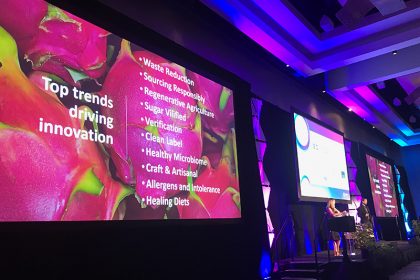
Good news for fermented food and drink brands. Today’s increasingly disruptive, consumer-driven economy is favoring brands that are craft and artisanal, source responsibly, reduce waste, nourish their microbiome and aim for better treatment of the planet. These are already core operating values for many fermentation brands.
“Consumer values are shifting in the marketplace; businesses are working hard to find ways to use their business as a force of good. Consumers are increasingly engaged in supporting the businesses that are looking to disrupt the status quo, that are looking to change,” said Eric Pierce, vice president of strategy and insights for New Hope Network. “Our market is moving in this direction with more innovation, with more access, with more options for consumers that are easier for them to get a hold of…we will find more and more people opting into the products we are bringing to the marketplace.”
The top trends driving the natural products industry were shared at a “What’s Next” session for industry leaders at Expo East. Here are six trends the fermentation industry can use to grow their company.
1. Brands Supporting the Planet
From the treatment of animals on the farm, the soil used to grow the vegetables and the type of packaging used, the environment is on the top of consumer’s minds. Consumers want to support brands that practice regenerative farming, zero waste production and responsible supply chain sourcing.
“The top three trends fell under purpose-driven commerce,” said Amanda Hart, market research manager for NEXT Data & Insights. She said consumers want brands to be more mindful, proactive and “really dive in and solve for community health and issues where government regulation is lagging or lacking.”
2. Selling Outside the Health Food Crowd
Since the start of the natural food industry, natural and organic foods were mostly purchased by a demographic of shoppers SPINS market research defines as “Core Natural/Organic.” These “true believers” and “enlightened environmentalists” make up the majority of natural industry shoppers.
Meanwhile, the mainstream consumer has traditionally been a harder group for brands to reach. These “indifferent traditionalists,” “struggling switchers” and “resistant non-believers” make up the smallest part of natural product sales.
That gap is closing – today 92 percent of all households buy organic products, and 99 percent buy natural products.
Pierce noted he was surprised when studying these groups that the reason they purchase natural products is now the same.
“What this means to us is their level of commitments to products in the industry, their level of commitment to brands is dramatically different,” Pierce said. “But consumers across our economy value similar things what it comes to what they’re looking for from us.”
“Increasingly, these products are resonating with mass retailers,” he continued.
The findings also showed the food trends that resonate with consumers were not influenced by their political leaning. Whether Democrat or Republican, consumers care about the same food values.
The top five food trends these groups care about: waste reduction, responsible sourcing, responsible meat and dairy, craft and artisanal and responsible packaging.
3. Expanding Knowledge of Microbiome
Probiotics – which has topped SPINS trend lists for years — is no longer claiming a top spot. This doesn’t mean consumers don’t care about gut health, though. Consumers are looking at different beneficial options for their microbiome.
“How can consumers cultivate a health microbiome, to make us our strongest selves as we navigate the forces of modern life?” Hart said.
There is lots of research on nourishing a healthy microbiome. Brands should market gut health to consumers, especially with scientifically-backed claims on how fermented foods aid the gut bacteria.
4. No Added Sugar
Sugar – especially added sugar – has long been the nemesis of natural food shoppers. But consumers now want blatant communication from brands on product flavoring.
“Sugar and sweetener are different, so some brands now are starting to leverage both of those terms and really communicate how they’re adding a sweet flavor to their product – or not adding,” Hart said.
Botanical flavoring is starting to become a sweetner alternative for brands.
5. Alcohol-Free Drinks
Concerned with their health and focused on mindful drinking, Americans are purchasing less alcohol. Data from industry tracker IWSR found that U.S. alcohol volumes are dropping every year. Beer was the lowest, with volumes down 1.5 percent in 2018 and 1.1 percent decline in 2017. Growth in wine and spirits also slowed. This is especially true among younger, millenial consumers.
The taste for a fermented craft beer or cocktail is not waning, though.
This trend was seen on the show floor, where more and more alcohol-free brands are marketing alcohol-free drinks, like non-alcoholic beers, sugar-free mocktails and sparkling vinegars.
6. DIY Rules
Consumers want to be part of the creative process, “like they’re building products for themselves,” Hart said. Pierce added: “consumers value innovation efforts…that engage their sense of adventure and exploration.”
Fermentation brands are catering to consumers DIY nature by offering recipes to experiment with their product, like kefir smoothies, kombucha cocktails or sauerkraut omelets. Some fermentation brands are even selling fermentation kits for home use.
